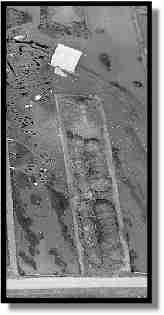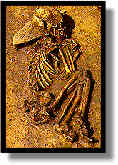
 Archaeological Excavation in Baden-Wurttemberg
Archaeological Excavation in Baden-Wurttemberg

A Bandkeramik village of the 6th millennium BC with cemetery near Vaihingen/Enz
Report for 1996
The city of Vaihingen is located on the western border of the middle Neckar region (between Stuttgart and Karlsruhe). The excavation - under direction of Dr. Rüdiger Krause - started in 1994 on a future industrial area. During the next years we will uncover a complete settlement of the Bandkeramik with one or several funeral places. All totally covering a surface of 80,000-100,000 m² (20-25 ac).
The village is located between the deeply cut valley of the Enz river and a softly inclined slope in the foreland of the Stromberg range. The remains of the settlement are clearly made out, due to their very good preservation conditions and a relatively minor erosion in comparison to normal loess soils conditions in the Neckar region.
 Teil
der Grabungsfläche - Luftaufnahme (31 kB JPEG)
Teil
der Grabungsfläche - Luftaufnahme (31 kB JPEG)
A good number of well-preserved ground
plans of the typical longitudinal houses
were discovered in the heavy and clayey loess, but more important, a
village ditch was found (1.50-2.00 m large with an
even trench bottom of 1.00-1.50 m width), reinforced by two to four
small ditches of former fences. The fence could be
traced in 1994 and in 1995 on a surface covering 20,000 m² (5
ac), reaching a length of 216 m and forming half an oval. The ditch is
being interrupted by at least three entries, partly
reinforced by posts on the inside and outside. This ditch is certainly
not considered as a fortification but more like an enclosure
surrounding a Medieval village.
 Plan of excavation in 1995 (JPG 44kB)
Plan of excavation in 1995 (JPG 44kB)
The area of the interior village seems to have
been subject to a regular division according to a systematic
plan, so you get the impression of long allotment lines. This
becomes especially obvious at the long rows of lateral ditches, which
follow on either side of the houses in NNW- SSE direction and between
whom the large houses were built. Due to the contrasting soil colors
caused by small wall ditches and post alignments, ground plans of at
least 20 large and small buildings could be
reconstructed, some of them reaching up to 32 m in length.
The distance between the center of a lateral ditch to the next measures always 9-10 m, while the space in between amounts uniformly to 7 m. The buildings, 4.80 m up to 5.20 m large, were constructed on these small surfaces. The village area was submitted to a clear and scheduled division plan from the beginning. House constructions were limited by the village ditch and did not exceed beyond this boundary.
A big surprise was the discovery of
presently 90 Bandkeramik graves, interred either in
the village ditch or in storage pits alongside the ditch. About 50
 contracted
burial(29 kB JPEG) were found in all filling layers of the
village ditch. Furthermore, 30 skeletons were excavated in lateral
house ditches or other pits, mostly in close vicinity to the ditch.
The deceased were usually buried in a crouched position, with strongly
bowed knees and arms folded in an angle. Only few examples give the
impression that the dead persons were thrown into the pits. Burial
gifts or parts of personal ornaments are a rare exception; there are
some few ceramic vessels, and, somewhat more frequently, single
potsherds.
contracted
burial(29 kB JPEG) were found in all filling layers of the
village ditch. Furthermore, 30 skeletons were excavated in lateral
house ditches or other pits, mostly in close vicinity to the ditch.
The deceased were usually buried in a crouched position, with strongly
bowed knees and arms folded in an angle. Only few examples give the
impression that the dead persons were thrown into the pits. Burial
gifts or parts of personal ornaments are a rare exception; there are
some few ceramic vessels, and, somewhat more frequently, single
potsherds.
The oldest settlement phase with the village enclosure belongs to the Flomborn phase (about 5600 till 5200 BC). Younger finds, however, reveal that on the area excavated in the years 1994/95 the begin of the Middle Bandkeramik period had been reached already and that the village existed probably until the younger Bandkeramik. As a working thesis we assume for this site the most ancient settlement phase (Flomborn) including the village enclosure. At a time yet to determine, the village ditch lost its original function and, together with the open adjacent settlement pits, was used as a cemetery. We suppose that, due to a rising population, the settlement area expanded gradually toward southeast. By no means are there any single farms or house units, which moved or circulated in a larger surrounding area. It is much more possible that the village has constantly developed, thus presenting a new type of Bandkeramik settlement.
Text by R. Krause, edited by W.M. Werner
22 Aug. 1998 - If you have any comments or questions, please contact me: Wolfgang M. Werner wmwerner@web.de
 24 kB JPEG
24 kB JPEG